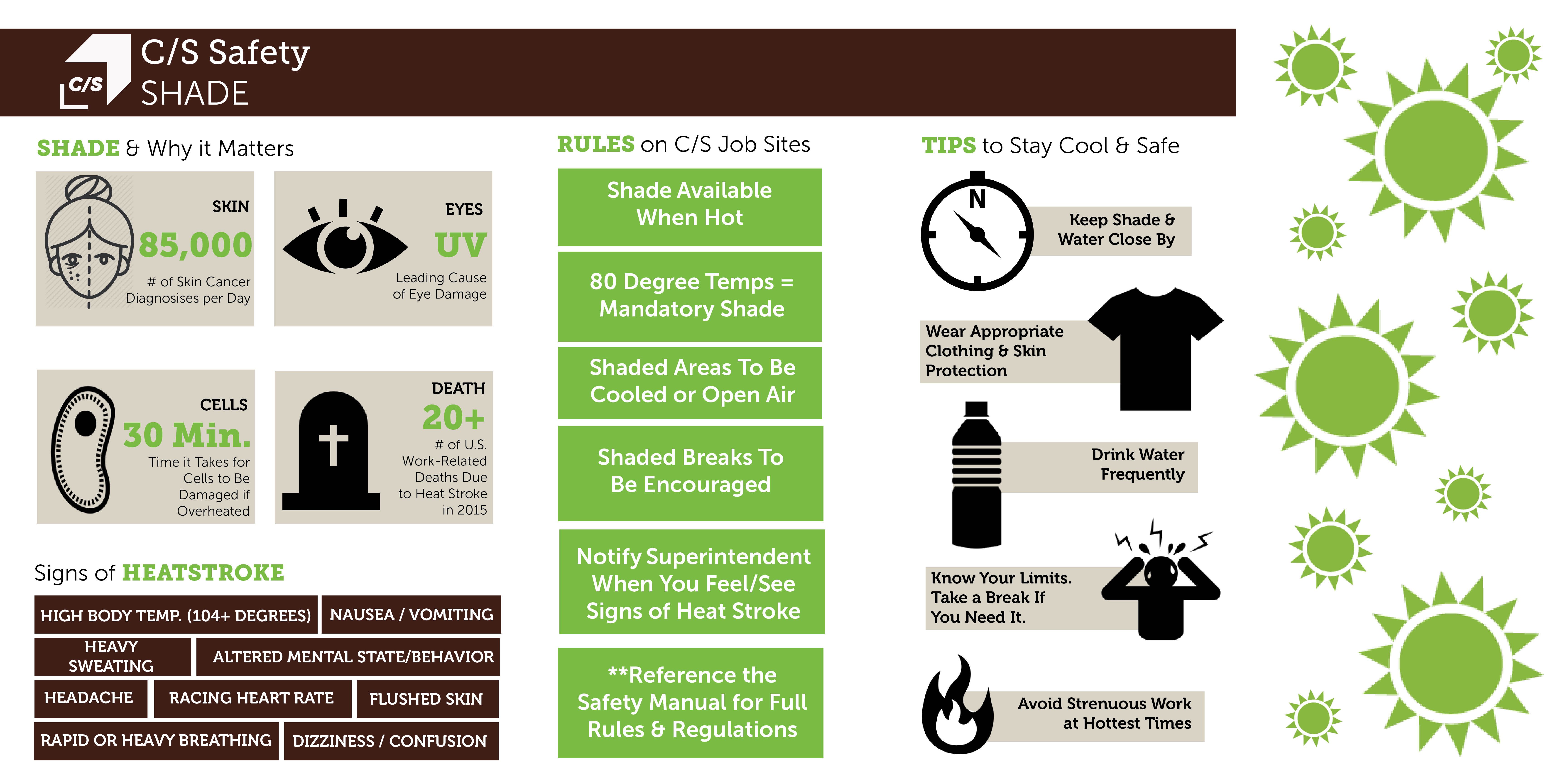With many of our job sites experiencing temperatures in the triple digits, it is more important than ever to know how to beat the heat through safe job site practices. Our safety committee is committed to ensuring that all job site team members are educated and aware of ways to stay safe, especially during the hot summer months.
“Our team members are fine craftsmen doing important work. We value their well being and want them to go home safely to their families at night.” – Larry Cabodi, C/S Senior Superintendent
Crews at Clark/Sullivan Construction are encouraged and/or required to adhere to the following rules and tips regarding summer job site safety.

Keeping your body hydrated is one of the fundamentals rules to healthy living. This is especially true when it comes to working in our industry. With your muscles, brain and blood consisting of mostly water, and high dehydration risks during the summer months, it is important to make sure that your body is getting more than enough water. Check out these tips for staying hydrated on the job site:
- Keep Water Close By: In many cases, crew members will forego drinking water because there isn’t any in sight. If a water bottle or drinking fountain is too far away, it’s hard to stop what you’re doing and run to get a drink. By keeping a water bottle near you, you are more likely to take quick breaks to hydrate more often.
- Avoid Sugary Drinks: Sugary liquids like energy drinks or juices help accelerate the dehydration process. Although they may give you energy or a sugar rush, be sure to choose water as your first choice when staying hydrated on the job site.
- Drink Water Frequently: Do not let your water breaks become infrequent. Make it a priority to stop for water breaks as much as you need to. No one will blame you for staying hydrated.
- Know Your Limits: When temperatures are high, so is the risk for over-doing it. Your body can only take so much stress, and adding heat to the equation can make work more stressful. Listen to your body to know when you need to take a break, drink water or slow down a bit.
- Keep Water Cool: There’s nothing like a refreshing drink of hot water… NOT! If water is left in the sun, crew members are less likely to drink it, therefore forgoing an opportunity to hydrate. Be sure to keep your water in an area that is cooled or shaded, if possible.

Hydration
Hydration and shade go hand-in hand when it comes to avoiding heat stroke during the hot summer months. With skin cancer as a factor, UV and cellular damage on the rise, and the risk of death to consider, check out these tips to make sure that you’re staying cool on the job site:
- Keep Shade Close By: It’s important to make sure that shade is nearby for breaks. If you are working in an area that many not have a structure or trees to use for shade, use canopies or easy-up style temporary shade structures.
- Wear Appropriate Clothing & Skin Protection: Be sure to wear skin and eye protection while on the job site. Sunglasses, sunscreen, hats, hard hats and SPF clothing will help decrease your chances of sunburns, UV damage and/or heat stroke. Believe it or not, long-sleeved shirts and long panys can actually help you stay cool in the summer and can help you avoid skin damage from harmful rays.
- Drink Water Frequently: We cannot emphasize this enough! Frequent hydration is key to avoiding heat stroke as your skin, eyes and cells all depend on adequate supplies of water.
- Know Your Limits: Always make sure you know how much you can handle. If you need to take a shaded break, take one. Do not push yourself past your limit as it will put you at risk for heat stroke.
- Avoid Strenuous Work During Hottest Hours: Learning how to budget your workload can help tremendously when it comes to working in the heat. Scheduling more strenuous work in the mornings when it’s cooler can help you avoid over-doing it in the afternoons when the temperatures are the highest for the day.
Remember
It is everyone’s duty to keep an eye out for others. If you notice one of your team members exhibiting signs of dehydration or heat stroke (i.e. nausea, fatigue, excessive sweating, decreased performance, etc.), be sure to alert your project superintendent immediately.
“We work as a team and stay safe as a team. Nothing is as important as the safety of the guys around you.” – Larry Cabodi, Superintendent